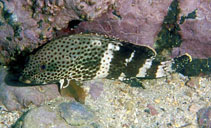| Family: |
Epinephelidae (Groupers) |
| Max. size: |
38 cm TL (male/unsexed) |
| Environment: |
reef-associated; marine; depth range 5 - 50 m |
| Distribution: |
Western Indian Ocean: Red Sea (including Gulf of Suez) and northwestern Indian Ocean to the coast of Pakistan. Specimens examined include those from the Gulf of Oman. Not reported from the Gulf of Aqaba nor from Persian Gulf. |
| Diagnosis: |
Dorsal spines (total): 11-11; Dorsal soft rays (total): 16-18; Anal spines: 3-3; Anal soft rays: 8-8. Body robust, preopercle with moderately enlarged serrae at its angle; upper edge of the operculum almost straight; nostrils subequal or posterior nostril slightly larger. Head and body yellowish gray, with dark orange-red or reddish brown spots except ventrally and posteriorly; dark gray bars running antero-ventrally from the base of the dorsal fin; a dark saddle blotch on the caudal peduncle. Fins generally yellowish brown; median fins with broad yellowish margin posteriorly (Ref. 89707). |
| Biology: |
Occurs on shallow sandy bottoms near small coral heads; it is not known from well-developed coral reefs (Ref. 5222). Nothing has been published on its biology nor its use in fisheries (Ref. 5222). Sold fresh in local markets (Ref. 5222). |
| IUCN Red List Status: |
Least Concern (LC); Date assessed: 02 November 2017 Ref. (130435)
|
| Threat to humans: |
harmless |
Source and more info: www.fishbase.org. For personal, classroom, and other internal use only. Not for publication.

